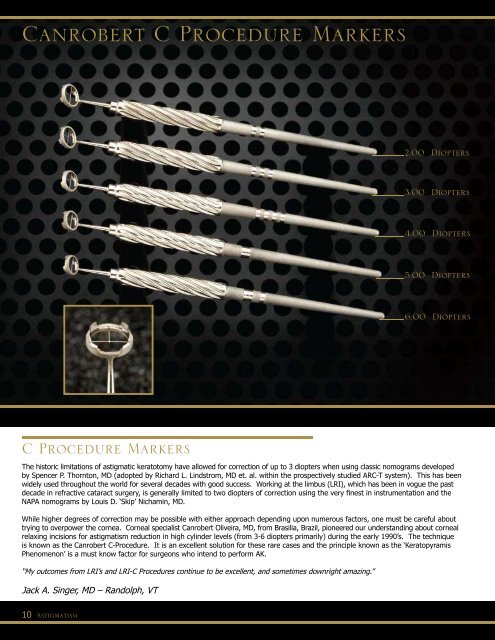Catalogue - Mastel Precision
Catalogue - Mastel Precision
Catalogue - Mastel Precision
You also want an ePaper? Increase the reach of your titles
YUMPU automatically turns print PDFs into web optimized ePapers that Google loves.
Canrobert C Procedure Markers<br />
C Procedure Markers Corneal Markers<br />
The historic limitations of astigmatic keratotomy have allowed for correction of up to 3 diopters when using classic nomograms developed<br />
by Spencer P. Thornton, MD (adopted by Richard L. Lindstrom, MD et. al. within the prospectively studied ARC-T system). This has been<br />
widely used throughout the world for several decades with good success. Working at the limbus (LRI), which has been in vogue the past<br />
decade in refractive cataract surgery, is generally limited to two diopters of correction using the very finest in instrumentation and the<br />
NAPA nomograms by Louis D. ‘Skip’ Nichamin, MD.<br />
While higher degrees of correction may be possible with either approach depending upon numerous factors, one must be careful about<br />
trying to overpower the cornea. Corneal specialist Canrobert Oliveira, MD, from Brasilia, Brazil, pioneered our understanding about corneal<br />
relaxing incisions for astigmatism reduction in high cylinder levels (from 3-6 diopters primarily) during the early 1990’s. The technique<br />
is known as the Canrobert C-Procedure. It is an excellent solution for these rare cases and the principle known as the ‘Keratopyramis<br />
Phenomenon’ is a must know factor for surgeons who intend to perform AK.<br />
“My outcomes from LRI’s and LRI-C Procedures continue to be excellent, and sometimes downright amazing.”<br />
Jack A. Singer, MD – Randolph, VT<br />
2.00 Diopters<br />
3.00 Diopters<br />
4.00 Diopters<br />
5.00 Diopters<br />
6.00 Diopters<br />
10 Astigmatism Corneal Markers 11<br />
AK/LRI 7mm - 11mm<br />
Capsulorhexis 5mm-6mm<br />
Lasik 2.5mm-5mm<br />
Optical Zone Markers<br />
9.00 mm<br />
8.00 mm<br />
7.00 mm<br />
6.00 mm<br />
5.75 mm<br />
5.50 mm<br />
5.25 mm<br />
5.00 mm<br />
4.75 mm<br />
4.50 mm<br />
4.25 mm<br />
4.00 mm<br />
3.75 mm<br />
3.50 mm<br />
3.25 mm<br />
3.00 mm<br />
2.75 mm<br />
2.50 mm<br />
“I use the <strong>Mastel</strong> 5.75 mm corneal marker every time I use a ReZoom or ReSTOR lens (I offset a fraction of a millimeter inferior and<br />
nasal within the related pupil). The corneal mark is a perfect guide for the capsulorhexis, which is perfect every time. The IOL is<br />
centered, the PCO rate is very low (20% in multifocal) and the patient and surgeon are ‘20/happy’.”<br />
Sharon Richens, MD - St. George, Utah<br />
“The capsulorhexis marker is a wonderful little helper with the ever persisting challenge of having a rhexis opening that is as big<br />
as possible, and as small as necessary to have the lens covered 360°. Yes, we are all experienced - and, yes, we have all had the<br />
disappointing experience, where we would have bet our head that we got it right - yet were fooled by a large eye, an asymmetric<br />
pupil and/or so many other distracters. A simple mark - you don’t guess, but know, where you are...”<br />
Thomas F. Neuhann, MD - Munich, Germany


